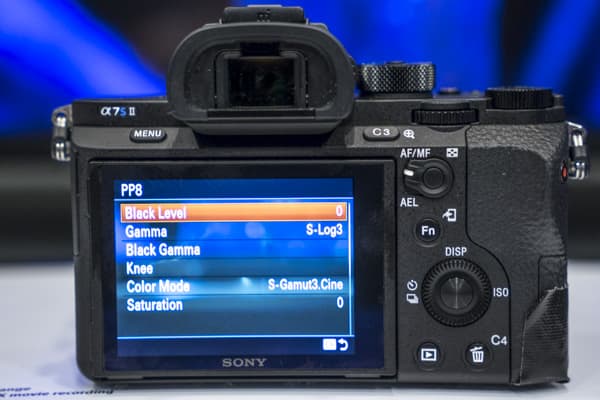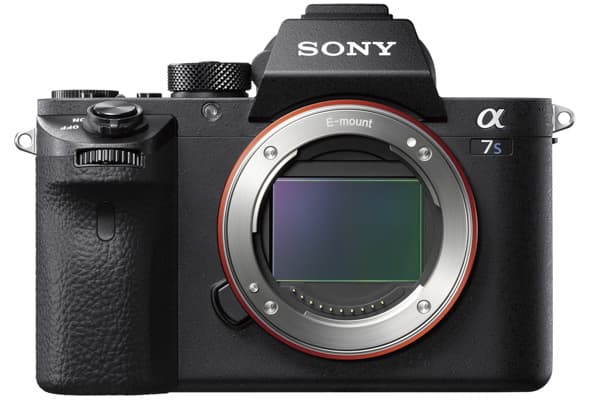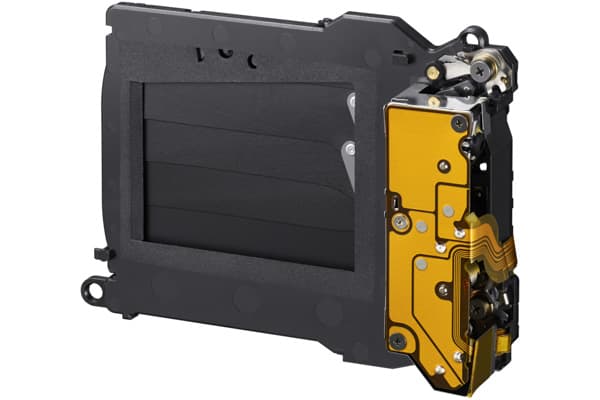With both the Sony A7 and A7R now being on their second generation, it was only a matter of time before the A7S went the same way. As such the A7S II is a mixture of refinements to the original camera and updates that we have previously seen on the A7 II and A7R II.
One of the first areas that has been updated is the viewfinder. The A7S II now has the same EVF that the A7R II, being a XGA OLED Tru-Finder with a resolution of 2,359,296 dots. We found that the viewfinder is very responsive, and with a high level of detail.
Like the other A7 cameras, the rear screen of the A7S II is a 3inch 1,228,800 dot articulated model, and once again, it is a shame that Sony hasn’t introduced at least some touch-screen functionality.
Certain features are now becoming standard in across all cameras, so it is no surprise to see that the A7S II has built-in wifi and NFC features, and if you are an existing Sony user, then you will be pleased to hear that the A7S II uses the same NP-FW50 battery that has featured in all Sony’s CSC cameras since the first NEX-3 and NEX-5.
Image Sensor
For those that aren’t familiar with original A7S, it uses a full frame 12.2-million-pixel CMOS sensor. The combination of moderate resolution and large sensor size means that the A7S has a sensitivity range of ISO 100-102,400. This can be expanded to an impressive ISO 50-409,600. With the same sensor, the A7S II has the same sensitivity range, but improvements to image processing algorithm mean that the noise to signal ratio has been improved slightly, resulting in lower noise. There was no indication as to just how much better the image quality is – we were not allowed to save any images with the pre-production camera that we used. With the image quality at high sensitivities already outstanding on the A7S, we’re looking forward to seeing just what the second generation camera is capable of.
Autofocus
With the A7S II using the same image sensor as its predecessor, it doesn’t employ the on-sensor phase detection that is found in the A7 II and A7R II. Instead contrast detection AF is used, but this has also been improved from the original camera. The camera has 169 AF points, which go almost from edge to edge, but with a higher concentration in the centre of the frame for more accuracy. With an f/2 lens attached Sony claim that the a7S II can focus at -4EV, which is impressive and is just many reasons why those who shoot in low-light will love the A7S II.
The speed of focusing has been improved though, presumably with upgrades to the internal processing systems. This means the camera focuses faster, particularly in video where the AF speed is now quoted as being twice as fast.
New Shutter
With its high sensitivity settings and low noise, the A7S is a popular camera with wedding and events photographs, enabling them to take photos discretely without the use of flash. Added to this, the A7S had a silent shooting mode with an electronic shutter. This meant that photographers could take images completely unnoticed.
The new A7S II takes this even further by improving the mechanical shutter mechanism so that it is 50% quieter than the original camera. With the A7S II bound to attract the attention of professional photographers the shutter in the A7S II has been tested to 500,000 cycles. With the use of the electronic shutter in certain situations the A7S II should last for years of use.
Build and Handling
Externally there is very little report on. The body of the A7S II matches that of the other second generation cameras. Like these cameras, the grip of the A7S II has been slightly reworked, and the front dial and shutter button moved to a more prominent position on the hand grip. As we have discussed in our previous reviews, the new body design is an improvement on the original A7 cameras, but it isn’t the most significant upgrade in the A7S II.
The A7S II now features a completely magnesium alloy body, offering the strength that professional photographers and videographers will demand. Added to this the lens mount has also been strengthened, as it has also been on the A7R II. The strengthening should be reassuring to those who plan to use the A7S II with adapters and third-party lenses, where the extra weight may put additional strain on the mount.
Stabilisation
The original range of A7 cameras relied upon lens based image stabilisation, but the A7 II introduced sensor based stabilisation, which has also recently featured in the A7R II. Sony claim that the 5-axis image stabilisation will allow photographers to shoot at around 4.5EV slower shutter speeds than usual. We have been very impressed with this same stabilisation in the A7 II and A7R II, and it will hopefully combine well with the high sensitivity shooting to enable photographers to shoot handheld in low light.

Video
With its large sensor, high sensitivity and low noise, the Sony A7S was hugely popular for videographers. There was one slight issue, and that was the fact that although it could output 4K video footage to an external recorder, it couldn’t save this footage internally. We have recently seen the Sony A7R II record 4K footage internally, so it was expected that the A7S II would also have this ability, and it doesn’t disappoint.
As well as being able to shoot at 1080p, the A7S II can now save 3840 x 2160 4K footage at either 24, 25 or 30fps. The footage is recorded in an XAVC S format, with an MP4 wrapper and 4:2:0 colour sampling with the option of either 100 or 60Mbps bit-rates.
Taking the Sony A7S II in the professional realm are the Sony Picture Profiles. These profiles offer a huge variety of different options for changing the black and white points, as well as the gamma curves and colour. There are a number of built-in presets. These allow the same video footage to matched across different Sony cameras that also have the Picture Profile settings. This seems to be something of a standard with Sony, with the RX10 II, RX100 II and A7R II also now having this ability.

There are new additions in the Profile settings, and these are the new S-Gamut3.Cine/S-Log3 and S-Gamut3/S-Log3 contrast curves. These are in addition to the S-Log2 setting that has previously been available. The new settings offer a wide colour gamut and maximise the dynamic range for video use, offering better tonal reproduction in the shadow and 18% midtone areas. This should enable videographers to get the flattest possible video footage for post-production editing.
Standard definition video has also been improved with the A7S II now having the ability to shoot at up to 120fps. This allows for internal slow motion recording at up to 5x slower than reality.
There is a while host of other video settings, that we will look at in more detail on www.thevideomode.com when the camera comes in for review.
First Impressions
Although the recent A7R II was a huge advancement over its predecessor, the A7S II is much more of a refinement of the original A7S. The changes are also somewhat predictable. With the A7R II recording 4K internally, it was only a matter of time before the A7S II with 4K internal recording became a reality. However, that doesn’t mean that there isn’t anything to get excited about. The original A7S is a fantastic camera, and 5-axis image stabilisation, improved build and handling, internal 4K recording, slow motion video and improved AF should all be the icing on the cake.
The A7S II looks like a fantastic camera that buckles the trend for cameras with increasingly high resolutions, and that is what many photographers have been asking for. They don’t want more and more pixels, they want a higher dynamic range and less noise.
The real test will come when we have a full working sample of the camera and can see exactly what the differences in image quality are between the two cameras. For videographers there is certainly a reason for the new camera, whilst professional wedding and event photographers will surely make a beeline towards the A7S II and its quieter shutter, faster focusing and image stabilisation.









